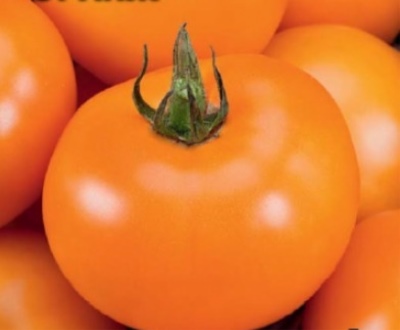
- Authors: Kozak V.I., Samovol A.P., Gorobets V.N., Kosenko S.N.
- Year of approval: 2000
- Category: grade
- Growth type: determinant
- Appointment: fresh consumption
- Ripening period: early
- Ripening time, days: 97-103
- Growing conditions: for open ground
- Bush size: undersized
- Bush height, cm: 35-40 (70-80 )
For admirers of exotic varieties of tomatoes, as well as for allergy sufferers who cannot afford to eat red tomatoes, the Orange nightshade crop will certainly become a regular guest in the garden or in the film greenhouse.
Breeding history
This exotic vegetable was bred by Russian breeders (Gorobets, Samovol, Kozak and Kosenko) more than 20 years ago. The nightshade crop appeared in the State Register of Breeding Achievements of the Russian Federation in 2000. In the same year, the variety was allowed for use. Recommended for growing Orange tomatoes in all climatic zones of Russia. The most productive plant is when growing in open ground.
Description of the variety
Orange tomatoes grow on low-growing bushes of the determinant type, reaching a height of 35-40 cm. In some cases, the plant grows up to 70-80 cm. It is characterized by a semi-sprawling plant with moderate green foliage, an erect central stem, flexible branches, a developed root system and simple inflorescences. The formation of the first fruit cluster occurs above the 6-7 leaves, where 5-6 berries are tied. On average, up to 4-5 fruit clusters are formed on a healthy tomato bush.
When caring for a plant, there is no need to form a bush. Whether or not to tie the stem and branches to the support depends on how many berries are ripening on the bush. Regular pinching should be carried out, if this is not done, this can negatively affect the quality of the fruits and yield indicators.
The main qualities of the fruit
Orange tomato stands out from the multitude of nightshades for its colorful color and incredible taste. The tomato is a medium-sized variety. The tomato weighs 91-96 grams. When ripe, the tomato is evenly covered with a bright orange color. The unripe fruit is light green with a speck at the base. The shape of the berries is correct - flat-round, with a perfectly smooth surface. The peel of tomatoes is of medium density, which is a protective barrier against mechanical damage (cracking). In addition, tomatoes are transportable and can be stored for a long time under certain conditions.
It is also worth noting that orange tomatoes, which look like tangerines, can ripen at room temperature. The variety belongs to universal, therefore it is eaten fresh, processed and canned.
Taste characteristics
Orange tomato is endowed with excellent taste. Its pulp is fleshy, moderately dense, juicy, with few seeds. The taste is dominated by sweetness, harmoniously complemented by light sourness and dessert aroma. There are no voids inside the berries, and the wateriness is not felt in the taste. The advantage of orange tomatoes is their composition, which contains useful components and beta-carotene, which allows vegetables to be used in dietary nutrition.
Ripening and fruiting
The nightshade culture belongs to the early maturing.It takes a little more than 3 months (97-103 days) from the full germination of seeds to the ripening of tomatoes on the brushes. Ripening of tomatoes occurs amicably, so ripe berries can be removed from the bushes with whole brushes. The maximum number of tomatoes is harvested from mid-July to late summer.
Yield
The variety brings good harvest. If agrotechnical recommendations are observed, from 1 m2 per season, you can collect from 4.9 to 6.2 kg of sweet and aromatic fruits.
The timing of planting seedlings and planting in the ground
Sowing seeds for seedlings is best done at the end of March (55-60 days before transplanting). The seed is preliminarily disinfected and treated with a growth stimulator. To accelerate the germination of seedlings, it is enough for them to organize a greenhouse effect from glass or cellophane. The sprouts should appear in 4-5 days. When 3-4 real leaves appear on the bushes, then they are seated in separate containers.
A transplant to a garden bed is carried out in early June, when the air and soil are well warmed up. It is best to do this when the weather is clear and calm.

Growing tomato seedlings is an extremely important process, because it largely depends on whether the gardener will be able to harvest at all. All aspects must be taken into account, from seedbed preparation to planting in the ground.
Landing scheme
Along with comprehensive care, the plants must also be correctly placed in the garden. Up to 5-6 bushes can be planted per 1 m2, which will provide access to light and air for seedlings, as well as convenient plant care. The optimal layout for planting is 40x40 cm.

Growing and care
The best soil for growing tomatoes is a fertile, loose soil with low acidity, which is sufficiently illuminated by the sun. Comprehensive care includes watering, fertilizing, weeding the land, tying bushes, pinching, preventing ailments.




A plant needs different micronutrients at each stage of growth. All fertilizers can be divided into two groups: mineral and organic. Folk remedies are often used: iodine, yeast, bird droppings, eggshells.
It is important to observe the rate and period of feeding. This also applies to folk remedies and organic fertilizers.
Disease and pest resistance
The plant has good immunity to many diseases of the nightshade - apical rot, tobacco mosaic virus, late blight. Among the pests that attack tomatoes, the most common are the bear, aphid, whitefly and wireworm. Preventive spraying will help protect against viruses and insects.



























































































